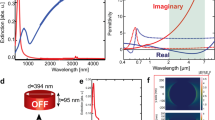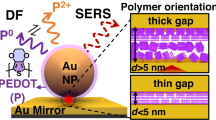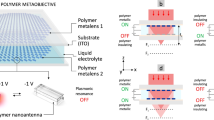Abstract
Being able to dynamically shape light at the nanoscale is one of the ultimate goals in nano-optics1. Resonant light–matter interaction can be achieved using conventional plasmonics based on metal nanostructures, but their tunability is highly limited due to a fixed permittivity2. Materials with switchable states and methods for dynamic control of light–matter interaction at the nanoscale are therefore desired. Here we show that nanodisks of a conductive polymer can support localized surface plasmon resonances in the near-infrared and function as dynamic nano-optical antennas, with their resonance behaviour tunable by chemical redox reactions. These plasmons originate from the mobile polaronic charge carriers of a poly(3,4-ethylenedioxythiophene:sulfate) (PEDOT:Sulf) polymer network. We demonstrate complete and reversible switching of the optical response of the nanoantennas by chemical tuning of their redox state, which modulates the material permittivity between plasmonic and dielectric regimes via non-volatile changes in the mobile charge carrier density. Further research may study different conductive polymers and nanostructures and explore their use in various applications, such as dynamic meta-optics and reflective displays.
This is a preview of subscription content, access via your institution
Access options
Access Nature and 54 other Nature Portfolio journals
Get Nature+, our best-value online-access subscription
$29.99 / 30 days
cancel any time
Subscribe to this journal
Receive 12 print issues and online access
$259.00 per year
only $21.58 per issue
Buy this article
- Purchase on Springer Link
- Instant access to full article PDF
Prices may be subject to local taxes which are calculated during checkout




Similar content being viewed by others
Data availability
The data that support the plots within this paper and other findings of this study are available from the corresponding author upon reasonable request.
References
Shaltout, A. M., Shalaev, V. M. & Brongersma, M. L. Spatiotemporal light control with active metasurfaces. Science 364, eaat3100 (2019).
Maier, S. A. Plasmonics: Fundamentals and Applications (Springer Science & Business Media, 2007).
Massonnet, N., Carella, A., de Geyer, A., Faure-Vincent, J. & Simonato, J.-P. Metallic behaviour of acid doped highly conductive polymers. Chem. Sci. 6, 412–417 (2015).
Gueye, M. N. et al. Structure and dopant engineering in PEDOT thin films: practical tools for a dramatic conductivity enhancement. Chem. Mater. 28, 3462–3468 (2016).
Chen, S. et al. On the anomalous optical conductivity dispersion of electrically conducting polymers: ultra-wide spectral range ellipsometry combined with a Drude–Lorentz model. J. Mater. Chem. C 7, 4350–4362 (2019).
Aasmundtveit, K. E. et al. Structure of thin films of poly(3,4-ethylenedioxythiophene). Synth. Met. 101, 561–564 (1999).
Poddubny, A., Iorsh, I., Belov, P. & Kivshar, Y. Hyperbolic metamaterials. Nat. Photonics 7, 948 (2013).
Hanarp, P., Käll, M. & Sutherland, D. S. Optical properties of short range ordered arrays of nanometer gold disks prepared by colloidal lithography. J. Phys. Chem. B 107, 5768–5772 (2003).
Stete, F., Koopman, W. & Bargheer, M. Signatures of strong coupling on nanoparticles: revealing absorption anticrossing by tuning the dielectric environment. ACS Photonics 4, 1669–1676 (2017).
Chang, W.-S. et al. Tuning the acoustic frequency of a gold nanodisk through its adhesion layer. Nat. Commun. 6, 7022 (2015).
Fang, Z. et al. Active tunable absorption enhancement with graphene nanodisk arrays. Nano Lett. 14, 299–304 (2013).
Knight, M. W. et al. Aluminum for plasmonics. ACS Nano 8, 834–840 (2013).
Langhammer, C., Yuan, Z., Zorić, I. & Kasemo, B. Plasmonic properties of supported Pt and Pd nanostructures. Nano Lett. 6, 833–838 (2006).
Wokaun, A., Gordon, J. P. & Liao, P. F. Radiation damping in surface-enhanced Raman scattering. Phys. Rev. Lett. 48, 957 (1982).
Bredas, J. L. & Street, G. B. Polarons, bipolarons, and solitons in conducting polymers. Acc. Chem. Res. 18, 309–315 (1985).
Lee, S. H. et al. Switching terahertz waves with gate-controlled active graphene metamaterials. Nat. Mater. 11, 936 (2012).
Alam, M. Z., De Leon, I. & Boyd, R. W. Large optical nonlinearity of indium tin oxide in its epsilon-near-zero region. Science 352, 795–797 (2016).
Kim, N. et al. in Conjugated Polymers: Properties, Processing, and Applications (eds Reynolds, J. R., Thompson, B. C. & Skotheim, T. A.) 44–127 (CRC, 2019).
Fabiano, S. et al. Poly(ethyleneimine) impurities induce n‐doping reaction in organic (semi)conductors. Adv. Mater. 26, 6000–6006 (2014).
Jiang, N., Shao, L. & Wang, J. Gold nanorod core)/(polyaniline shell) plasmonic switches with large plasmon shifts and modulation depths. Adv. Mater. 26, 3282–3289 (2014).
Jung, I. et al. Surface plasmon resonance extension through two-block metal-conducting polymer nanorods. Nat. Commun. 9, 1010 (2018).
Li, S. Q. et al. Infrared plasmonics with indium–tin-oxide nanorod arrays. ACS Nano 5, 9161–9170 (2011).
Lauchner, A. et al. Molecular plasmonics. Nano Lett. 15, 6208–6214 (2015).
Rodrigo, D. et al. Mid-infrared plasmonic biosensing with graphene. Science 349, 165–168 (2015).
Mitraka, E. et al. Oxygen-induced doping on reduced PEDOT. J. Mater. Chem. A 5, 4404–4412 (2017).
Mei, J. & Bao, Z. Side chain engineering in solution-processable conjugated polymers. Chem. Mater. 26, 604–615 (2013).
Xu, J. et al. Multi-scale ordering in highly stretchable polymer semiconducting films. Nat. Mater. 18, 594–601 (2019).
Vijayakumar, V. et al. Bringing conducting polymers to high order: toward conductivities beyond 105 S cm−1 and thermoelectric power factors of 2 mW m−1 K−2. Adv. Energy Mater. 9, 1900266 (2019).
Larkin, P. Infrared and Raman Spectroscopy: Principles and Spectral Interpretation (Elsevier, 2017).
Brooke, R. et al. Vapor phase synthesized poly (3,4-ethylenedioxythiophene)-trifluoromethanesulfonate as a transparent conductor material. J. Mater. Chem. A 6, 21304–21312 (2018).
Kühne, P. et al. Advanced terahertz frequency-domain ellipsometry instrumentation for in situ and ex situ applications. IEEE Trans. Terahertz Sci. Technol. 8, 257–270 (2018).
Tompkins, H. & Irene, E. A. Handbook of Ellipsometry (William Andrew, 2005).
Weaver, J. H. & Frederikse, H. P. R. in CRC Handbook of Chemistry and Physics 74th edn (ed. Lide, D. R.) 1993–1994 (1993).
Philipp, H. R. in Handbook of Optical Constants of Solids Vol. 1 (ed. Palik, E.) 749–763 (Elsevier, 1997).
Tsuda, S., Yamaguchi, S., Kanamori, Y. & Yugami, H. Spectral and angular shaping of infrared radiation in a polymer resonator with molecular vibrational modes. Opt. Express 26, 6899–6915 (2018).
Beadie, G., Brindza, M., Flynn, R. A., Rosenberg, A. & Shirk, J. S. Refractive index measurements of poly(methyl methacrylate) (PMMA) from 0.4–1.6 μm. Appl. Opt. 54, F139–F143 (2015).
Acknowledgements
The authors thankfully acknowledge financial support from the Swedish Research Council, the Swedish Foundation for Strategic Research, the Wenner-Gren Foundation and the Swedish Government Strategic Research Area in Materials Science on Functional Materials at Linköping University (Faculty Grant SFO-Mat-LiU No. 2009 00971).
Author information
Authors and Affiliations
Contributions
M.P.J. conceived and supervised the project. S.C., V.S., P.K. and V.D. performed the ellipsometry measurements and data analysis. S.C. and M.S.C. fabricated the nanostructures. S.C., M.P.J. and E.S.H.K. performed numerical simulations. H.S. and S.C. performed PEI vapour treatments supervised by S.F. C.W. and M.F. performed the XPS measurements and analysis. S.C. performed all the other characterizations. S.C. and M.P.J. organized the data and wrote the manuscript. All the authors reviewed and commented on the manuscript.
Corresponding author
Ethics declarations
Competing interests
The authors declare no competing interests.
Additional information
Peer review information Nature Nanotechnology thanks Drew Evans and the other, anonymous, reviewer(s) for their contribution to the peer review of this work.
Publisher’s note Springer Nature remains neutral with regard to jurisdictional claims in published maps and institutional affiliations.
Supplementary information
Supplementary Information
Supplementary Section A: Discussion and Tables 1–2., Supplementary Section B: Discussion and Figs. 1–16, and refs. 1–5.
Rights and permissions
About this article
Cite this article
Chen, S., Kang, E.S.H., Shiran Chaharsoughi, M. et al. Conductive polymer nanoantennas for dynamic organic plasmonics. Nat. Nanotechnol. 15, 35–40 (2020). https://doi.org/10.1038/s41565-019-0583-y
Received:
Accepted:
Published:
Issue Date:
DOI: https://doi.org/10.1038/s41565-019-0583-y
This article is cited by
-
Metal to insulator transition for conducting polymers in plasmonic nanogaps
Light: Science & Applications (2024)
-
On the Plasmonic Properties of a Bi-Metallic Eccentric Ring-Disk Nanostructure
Plasmonics (2024)
-
Hyperbolic metamaterials: fusing artificial structures to natural 2D materials
eLight (2022)
-
Electro-active metaobjective from metalenses-on-demand
Nature Communications (2022)
-
Doped semiconducting polymer nanoantennas for tunable organic plasmonics
Communications Materials (2022)



